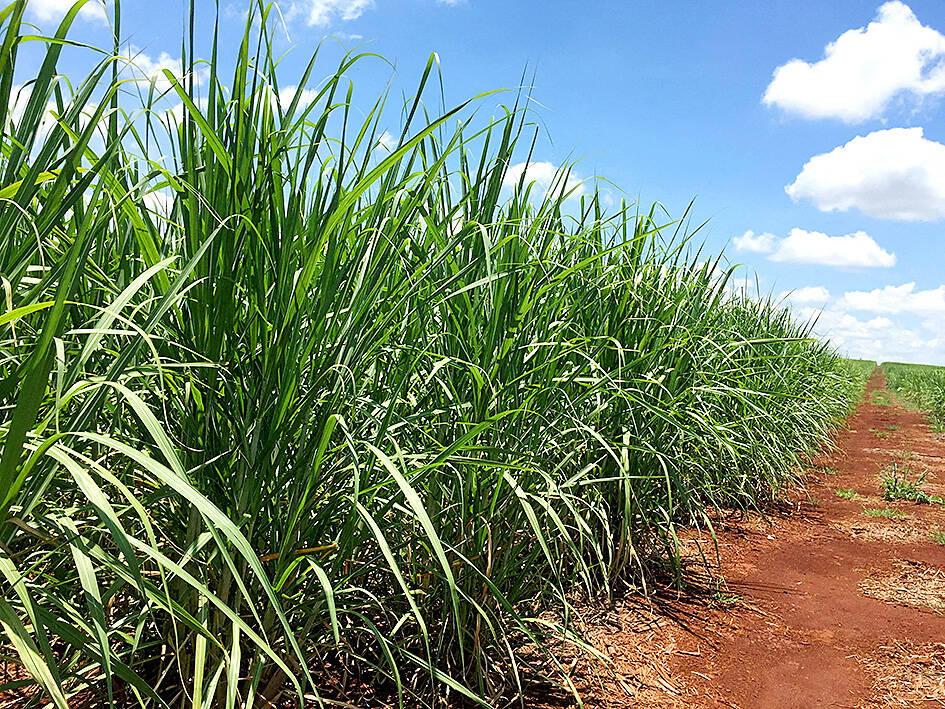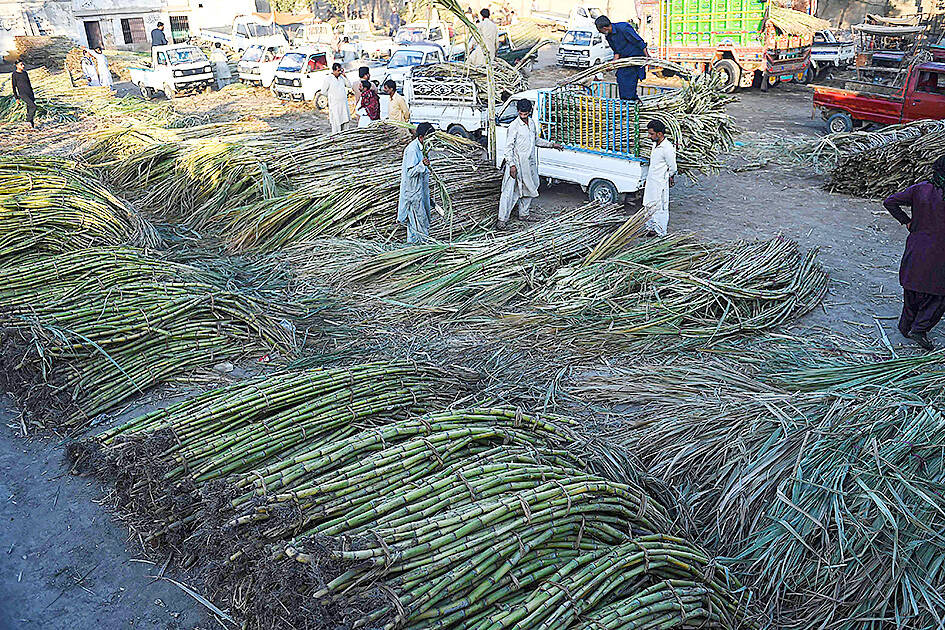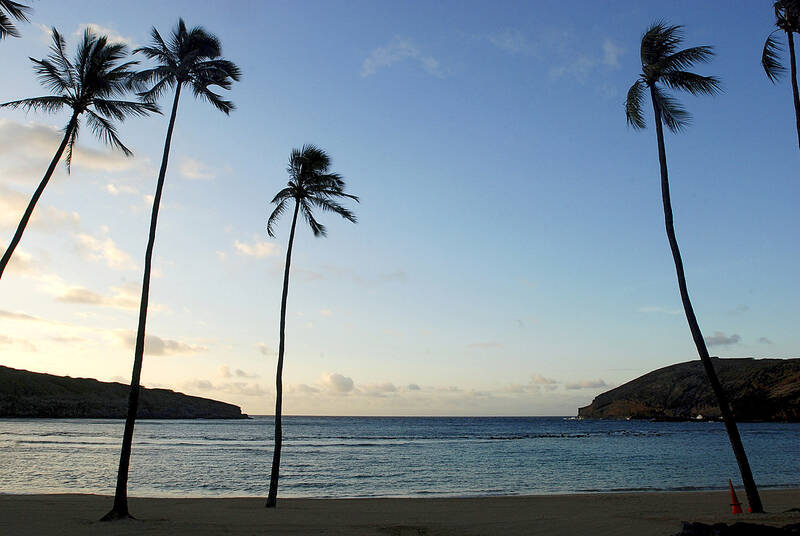Noa Kekuewa Lincoln remembers when he first encountered unique Hawaiian sugarcane varieties in 2004. The fresh stalks, bursting with color, might have sprouted from Willy Wonka’s imagination, not the soil.
Lincoln, a kanaka maoli (Native Hawaiian) expert in Indigenous cropping systems and an assistant professor at the University of Hawaii, said: “I grew up seeing grayish-green cane fields. But these canes are fluorescent pink, bright apple-green striped. They looked like huge cartoon candy canes. They almost don’t look real!”
That chance moment took Lincoln on a 20-year detour into researching Hawaii’s heirloom and native sugarcane varieties, neglected after centuries of plantation monoculture. Lincoln set out to identify native sugarcanes that existed before western contact and also heirloom canes, which have been growing in Hawaii for centuries. The point is, he said, to “treat them like the individuals they are.”

Photo: Reuters
He likens his research method to traditional navigation, “where you’re triangulating your position” in relation to known points. He interviews kupuna, or elders, in the Hawaiian community; dives into digitized archives of newspapers dating back to the 1830s; and culls information from stories, traditional medicines and chants.
A chant can offer information about how a sugarcane variety looks, where and how it grows, and its role in the ecosystem. A 19th-century chant celebrating a dignitary’s visit to Ni’ihau Island is one example: “My love returns to Ni’ihau / To the hidden waters of the pao’o fish / To the breadfruit that blossoms on the flats / The sugar cane of Halali’i dug out by hand.” It gives a location (Hawaii’s westernmost island), a name for the cane variety (Halali’i) dominant there, a tip on tending the plant and its proximity to breadfruit.
Lincoln marries these sources with modern tools like DNA analysis to see relationships between varieties of sugarcane. “For cane, some of the interpretations of the chants [and oral histories] only become clear when we are out in the field doing work and observe something that helps with the interpretation. It is very rarely just one line of knowledge that helps us understand, but multiple lines of knowledge intersect,” he said.

Photo: AFP
In one case, an elder said that a particular variety of sugarcane “called” dew from the north. Lincoln only grasped the full meaning of that statement when working with sugarcane in Kona. There, he realized that the crop cast tall shadows that preserved dew on the north side of its rows. And that substantially elevated soil moisture.
Through this research, he’s uncovered 25 Hawaiian sugarcane, or ko, varieties.
CANOE PLANTS

Photo: AP
Halali’I is one such variety. The name means “little hala,” or pandanus, a tree ubiquitous in the islands. Growing on windy Ni’ihau island, this sugarcane variety is frequently buried in sand so that only its top shows, resembling a small hala tree. Its other names mark how its leaves resemble sea lettuce, an edible green alga.
Many Hawaiian sugarcane varieties also share names with native fish. If the cane and the fish share similar striations or some other commonality, Hawaiians gave them the shared moniker. The black surgeonfish, common in Hawaiian reefs, and dark purple-black canes found on Kauai are both maikoiko. Maka’a means “glowing eye” and refers to the flagtail tilefish. It possesses bright blue eyes and gray-green stripes, like an extinct sugarcane with similar gray-green stripes.
Sugarcane was originally domesticated in New Guinea around 8000BC and brought to Hawaii as one of Polynesian voyagers’ original “canoe plants,” critical species that form the core of Hawaiian agriculture and foodways. The ancient islanders put sugarcane to various uses. Sugarcane windbreaks decrease wind damage to root crops and maintain soil moisture. Local sugarcanes provide mulch and attract nitrogen and nutrients into the soil. With those natural enhancements, Hawaiians were able to grow bigger and better sweet potatoes and taro alongside sugarcane, which itself adapted into new varieties suited to its new environs.
Though Native Hawaiians introduced sugarcane to the islands nearly a millennium before Europeans arrived, that fact often gets overshadowed in histories that focus on the impact and influence of sugarcane plantations that dominated the islands from the early 1800s onward.
Lincoln suspects that there are even more varieties, as his lab has uncovered about 80 names of traditional Hawaiian types. Try as his team might, they’re unable to connect all of them to existing plants due to the colonial erasure of both traditional knowledge and crops. By the 1840s, sugar was big business in Hawaii, and an 1875 treaty permitted Hawaii to sell sugar to the United States without having to pay taxes or duties, guaranteeing great profit and power for its planter class.
Today, Lincoln finds an ally in a businessman who worked in Hawaii’s once-robust sugarcane sector. Bob Gunter, president and CEO of Koloa Rum Company, worked with Amfac, considered one of Hawaii’s “big five” sugar businesses, and its Lihue plantation, one of the earliest and longest-running sugarcane operations. It closed in 2000.
Gunter said: “Hawaii was world renowned for its high-quality sugar and the concentration of its sugar. It produced tons of sugar per acre — quantities unheard of in other countries. But the trouble is that it couldn’t compete with countries that heavily subsidize sugar or don’t pay their labor well. It wasn’t a level playing field.” Koloa, which produces its rum from granulated cane sugar, had purchased tons of the ingredient from Hawaii’s plantations as they announced their closures. But eventually the rum maker had no alternative but to buy sugar from east Texas, Louisiana and Florida.
RUM FOR IT
Now a nascent industry is helping resurrect heirloom sugarcane. Agricole rum is distilled from freshly pressed sugarcane juice, as opposed to molasses or granulated sugar. Koloa and two other makers, Kuleana Rum Works and Ko Hana, consulted with Lincoln and now grow about 40 varieties of sugarcane that existed before western contact. Kuleana has been bottling and selling agricole rum since 2009 and Ko Hana started in 2009 as a farm, releasing its first agricole-style rum in 2014.
Gunter’s company plans to make rum from these heirloom canes, but production was delayed by the pandemic. “We’re preserving it, keeping a bank of sugarcane varieties, to perpetuate them, making sure we don’t lose them,” he said. “We’re currently at four acres and expanding to 10 to 12 acres of native cane.”
Lincoln attributes this renewed interest in ko to two movements: a larger one to reclaim Native Hawaiian identity, culture and cultivation practices, and the craft beverage movement, propelled by local distillers who see the use of heirloom Hawaiian canes as good marketing. “We can confidently say that more heirloom cane is being grown in Hawaii now than at any time in the past century,” he wrote in a 2022 article.
Still, Lincoln acknowledges the tension between economic and biocultural values of heirloom Hawaiian cane. On the one hand, businesses can appropriate Hawaiian knowledge and stories. Yet the fledgling rum agricole business “has provided new opportunities for preservation, dissemination and observations of the Hawaiian canes, as well as new platforms for sharing of indigenous perspectives,” he wrote in that same article. For example, when commercial producers grow large quantities of single varieties, scientists can better detect mutations within those varieties.
There is also a clear benefit to rum aficionados. Juice from heirloom sugarcanes can produce very different, fragrant rums. Lincoln said: “You wouldn’t dream of drinking a wine and not knowing what grape it came from.” Perhaps one day, more of us will sip Hawaiian rums and taste their distinct nuances.

Most heroes are remembered for the battles they fought. Taiwan’s Black Bat Squadron is remembered for flying into Chinese airspace 838 times between 1953 and 1967, and for the 148 men whose sacrifice bought the intelligence that kept Taiwan secure. Two-thirds of the squadron died carrying out missions most people wouldn’t learn about for another 40 years. The squadron lost 15 aircraft and 148 crew members over those 14 years, making it the deadliest unit in Taiwan’s military history by casualty rate. They flew at night, often at low altitudes, straight into some of the most heavily defended airspace in Asia.

Taiwan’s democracy is at risk. Be very alarmed. This is not a drill. The current constitutional crisis progressed slowly, then suddenly. Political tensions, partisan hostility and emotions are all running high right when cool heads and calm negotiation are most needed. Oxford defines brinkmanship as: “The art or practice of pursuing a dangerous policy to the limits of safety before stopping, especially in politics.” It says the term comes from a quote from a 1956 Cold War interview with then-American Secretary of State John Foster Dulles, when he said: ‘The ability to get to the verge without getting into the war is

Like much in the world today, theater has experienced major disruptions over the six years since COVID-19. The pandemic, the war in Ukraine and social media have created a new normal of geopolitical and information uncertainty, and the performing arts are not immune to these effects. “Ten years ago people wanted to come to the theater to engage with important issues, but now the Internet allows them to engage with those issues powerfully and immediately,” said Faith Tan, programming director of the Esplanade in Singapore, speaking last week in Japan. “One reaction to unpredictability has been a renewed emphasis on

Beijing’s ironic, abusive tantrums aimed at Japan since Japanese Prime Minister Sanae Takaichi publicly stated that a Taiwan contingency would be an existential crisis for Japan, have revealed for all the world to see that the People’s Republic of China (PRC) lusts after Okinawa. We all owe Takaichi a debt of thanks for getting the PRC to make that public. The PRC and its netizens, taking their cue from the Chinese Communist Party (CCP), are presenting Okinawa by mirroring the claims about Taiwan. Official PRC propaganda organs began to wax lyrical about Okinawa’s “unsettled status” beginning last month. A Global